City History
In the early 1820s, as possession of Florida ceded from Spain to the United States, there were but two principal cities – St. Augustine and Pensacola. For the first 2 sessions of the territorial legislature (1821-1823), the legislative body alternated the meeting site between Pensacola and St. Augustine. But, the perils of nineteenth century travel quickly became evident. Therefore, the state government sought a more convenient meeting site midway between the two cities. In 1823, territorial governor William Pope DuVal appointed an expedition to find a new meeting site. Upon the conclusion of the October 1823 expedition, the two appointees -- Dr. William H. Simmons (of St. Augustine) and John Lee Williams (of Pensacola) -- selected Tallahassee as the new site. Four months later, on March 4, 1824, Governor DuVal issued a proclamation naming Tallahassee as the legislature’s new meeting site. On May 24, 1824, Congress responded by setting aside a quarter-section of land with 3 additional quarter-sections in reserve (a full section being one square mile). ;In November 1824, the third session of the territorial legislature of Florida convened at newly-born Tallahassee. The next month, on December 29, 1824, the legislature created Leon County, in tribute to Spanish Explorer Juan Ponce de León.
The 1826 boundaries of the city were roughly Park Avenue to the north, Meridian Street on the east, Bloxham Street on the South, and M L King Jr Blvd. on the west.
The city charter is the governing document of the city, much like the Constitution is America’s governing document. The first City Charter was granted by the territorial legislature on December 9, 1825 and established the form of government as a strong mayor system with a 5-person city council. The initial charter laid the basic framework of government, set the municipal boundaries, provided for municipal officers (clerk, treasurer), elections, etc. Soon after, the original City Charter was superseded by new charters on January 18, 1827, February 13, 1831, and March 2, 1840. These early charters were prior to Florida’s admittance into the Union on March 3, 1845, when Florida became the 27th state. After statehood, the City of Tallahassee was re-chartered twice more on November 28, 1868 (a ministerial act to adhere to emancipation) and on February 20, 1920. From 1826 to 1919, the composition of the city council changed first to an 8-member council (1827) and later to a 9-member council (1874), to account for the 1869 act outlawing mayors holding a seat on a city council. Through this period, there were numerous directly-elected and appointed municipal officials including the clerk-treasurer, city marshal (chief of police), tax assessor, tax collector, market clerk, street contractor, cemetery sexton, and keeper of the clock. For much of this period, terms of office for all officials were for one year, but in the later years the terms of councilmen were for two years.
The 1920 City Charter abandoned the strong mayor system and converted to the commission-manager form of government. Under the 1920 charter, the old 9-member city council was replaced with a 3-member city commission whose members served 3-year terms. This 3-member commission then appointed a slate of officials to run the day-to-day operations of the municipal government. In 1920, these appointed officials were a city manager, auditor-clerk (who served as ex-officio tax assessor and tax collector), municipal judge, municipal prosecutor (solicitor), and city attorney. In 1950, the city commission was expanded to a 5-member board. In the early 1970s, the legislature abolished the municipal court system statewide and Tallahassee’s municipal judge and city solicitor positions ceased to exist. During the late 1970s, the terms of office for city commissioners was extended to four years. In 1982, the position of Auditor-Clerk was altered and the duties separated into two separate appointed officers, the City Treasurer-Clerk and City Auditor. From 1920 until 1996, the title of mayor and mayor pro tempore (i.e. pro tem) was rotated annually. In 1997, the City Charter was amended to provide for a directly-elected Leadership Mayor. Therefore, from 1997 onward, voters have chosen a mayor and four city commissioners. Concurrent with this change, the salary of mayor was set to match the salary of the chairman of the Board of County Commissioners and the salary of the remaining city commissioners was to equal one-half of the salary of the chairman of the Board of County Commissioners.
Since the 1984 municipal election, the City has contracted with the Leon County Supervisor of Elections for the conduct of city elections. In the late 1990s, city elections were moved from standalone spring elections to coincide with state & federal elections in August & November. This resulted in significant cost savings and greatly increased voter participation in city elections. In 2009, the City Charter was amended to delete the requirement for a special election should a vacancy occur. Since that time, all vacancies have been filled by interim appointment, with the term of the appointment running until the next regularly-scheduled election.
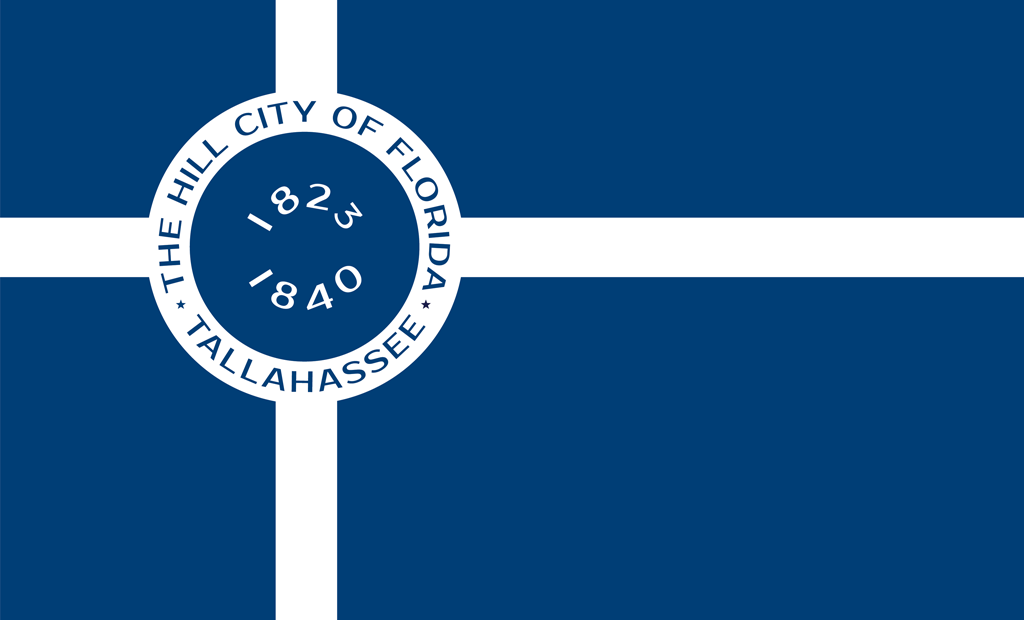
1916-1920s, Abernathy Flag |
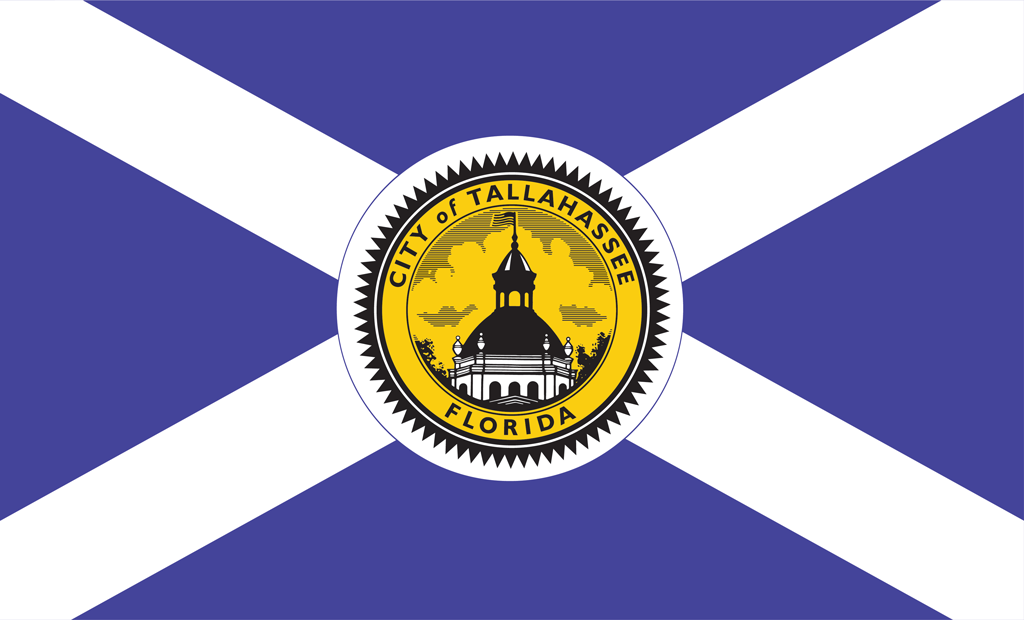
1955-1986, Walston Flag |
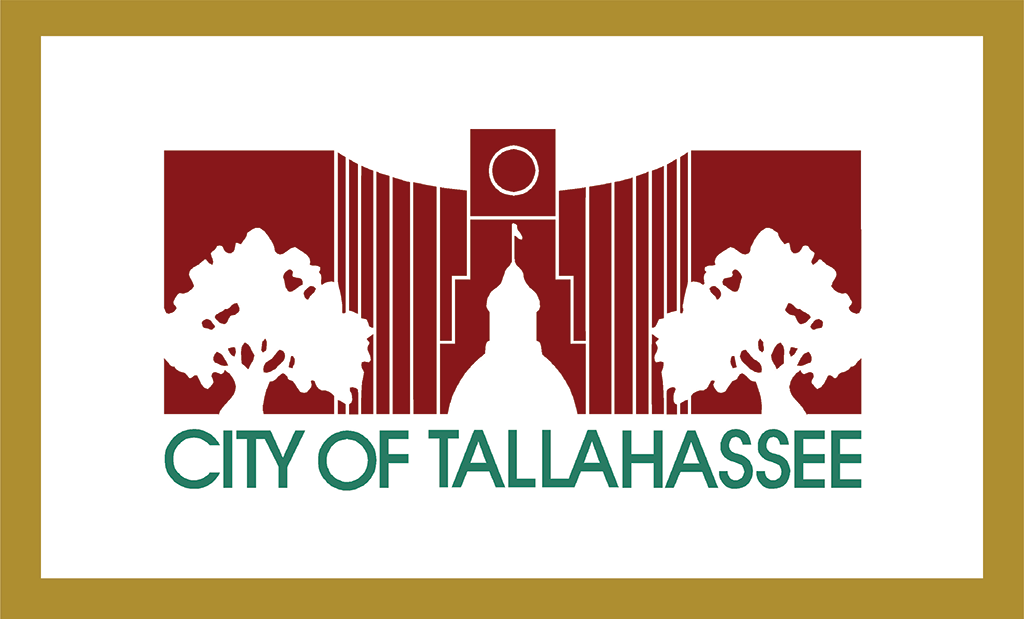
1986-2002, City Hall Silhouette Flag |

2002-2020, 5-point Star Flag |

2020-current, Coin Flag |
City Seal: Originally adopted on July 6, 1869 as part of efforts to align the City Charter with Reconstruction-era legislative mandates, the city seal has remained unchanged since the 1869. On this date, the municipal officials of that era must have looked to the previous March 2, 1840 city charter as they chose to include “Incorporated A.D. 1840” in the design of the seal. The city seal is used to emboss legal instruments (e.g. to sign, seal, & deliver an official document).
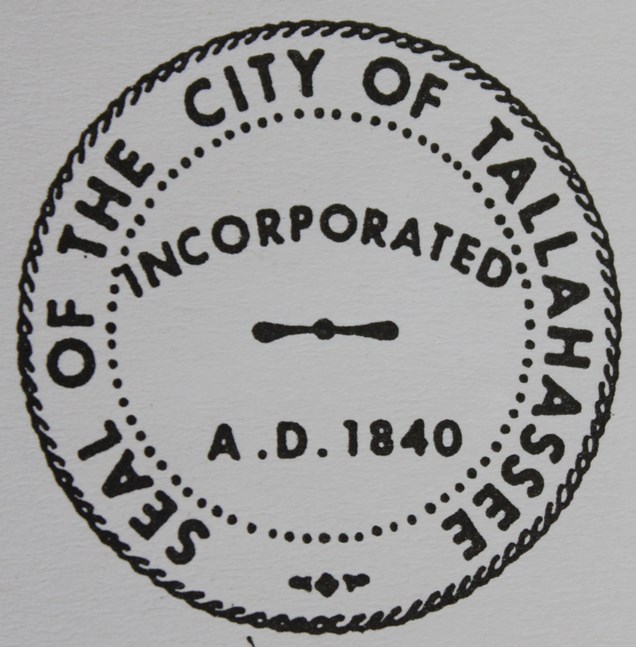
City Logo: Since at least 1929 the city logo featured the dome of the Old State Capitol. In the early 2000s, the city logo was replaced with an oak tree design, which remains in use today.
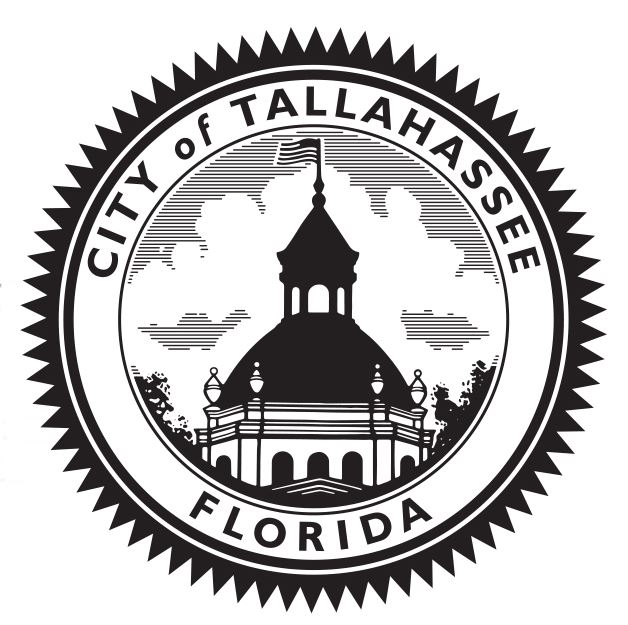
1929-2002
Capitol Dome Logo
|

2002-current
Oak Tree Logo
|
City Brand: During the “rebranding” effort of the early 2000s, the 5-point star brand was adopted, in cooperation with other local entities, such as Visit Tallahassee. The 5-point star has been incorporated into many city emblems since that time.
Current City Branding

Current
COT "Coin" Logo
|
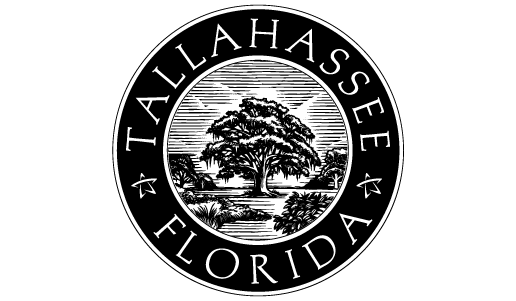
Current
Digital Oak Tree Logo
|
Population Chart
In Tallahassee’s early years, the population was small. This trend continued up until the end of World War Two when much of Florida experienced a population boom. After the war, many servicemen wished to return to Florida – a place where they training prior to overseas service. Since that time, population has steadily increased.
- First City Charter: December 9, 1825
- First City Officials: (1826) Mayor - Dr. Charles Haire; Clerk-Treasurer - George E Tingle
- First Police Force Organized: (1826)
- First Municipal Cemetery Opened: Old City Cemetery (1829)
- First Recorded Measurable Snowfall: (1829) 2” of snow fell. Other known snowfalls in 1864, 1891, 1894/1895, 1899, 1917, 1958, 1989 & 2018
- First (Documented) City Marshal: James Bryan, Jr (1831)
- First Financial Report Published: (1833)
- First Epidemic: Yellow Fever (1841)
- First Major Fire: The Great Fire (1843)
- First Municipal School: (1850-1853) After a brief closure, the school reopened in 1855 and evolved into Florida State University
- First Hurricane: (1851)
- First City Legal Case to go to Florida Supreme Court: Justus R Fortune v
- First Fire Chief: Thomas J. Rawls (1868)
- First City Seal Adopted: (1869)
- First African-Americans Elected (1871): William G Stewart (Clerk-Treasurer), Henry Sutton (City Marshal), Councilmen Jonathan C Gibbs, Jonas W Toer, & Everett C Jones
- First President of City Council Chosen: Simon L Tibbitts (1871)
- First African-American City Council President: Samuel C Watkins (1875) – served briefly as Acting Mayor
- First Telephone Co. Franchise Granted: (1895) City offices to be equipped with phones at no charge
- First US Supreme Court Case: Power Plant Case (1902)
- First City Electric Plant Construction Commenced: Sept. 1902, completed Feb. 1903
- First Paved Street: Gaines Street, from RR Depot to Adams St (1911)
- First Motorized Fire Engine: American LaFrance Engine (1916)
- First City Flag Adopted: Abernathy Flag (1916)
- First Officials Under Commission-Manager Gov’t:
- City Manager: John W. Greer (Feb 1920 – Nov 1922);
- Auditor-Clerk: Benjamin H Bridges Sr. (1920-1941);
- City Attorney: Fredrick T. Myers (1920-1927);
- City Judge: Alexander H Williams (1920-1931);
- Police Chief: Erastus R Isler;
- Fire Chief: Thomas P Coe.
- First Municipal Airport Opened: Dale Mabry Field (1929)
- First Fire Fighter Line-of-Duty Death: Lewin R. Spear (1930)
- First Electric Dept. Line-of-Duty Death: Wakulla C. McClamma (1930)
- First Municipal Golf Course acquired: Capital City Country Club (built 1914), deeded to City (1935)
- First Pension System Launched: Fireman’s Pension System: (1939)
- First Pension System for General Employees & Police Launched: (1941)
- First Female Auxiliary Police Officer: Mrs. F. C. Elliot (1942)
- First Female Regular Police Officer: Mrs. Elizabeth McLean (1944)
- First (Documented) Pensioner Retires: Phillip Young (1944)
- First Female Candidate for City Commission: Kathryn A. Gregory, Esq. (1950)
- First African-American Police Officers (post Reconstruction): Fred Douglas Lee, Sr.; Clarence Mitchell; & Freddie D. Golden (1952)
- First African-American Commission Candidate (post Reconstruction): Rev. King Solomon DuPont (1957)
- First African-American Commissioner (post Reconstruction): James R Ford, Sr. (1971)
- First African-American Fire Fighter: Earnest L. Adams (1971)
- First African-American Mayor: James R. Ford, Sr. (1972)
- First Female City Commissioner: Joan Heggen (1972)
- First Female Mayor: Joan Heggen (1973)
- First City-Owned Transit Service Goes into Operation: Tal-Tran (1973)
- First Female Fire Fighter: Mary Gardner (1979)
- First Police Officer Line-of-Duty Death: Reserve Sgt. Warren T Gay (1981)
- First City Auditor: James G. Gould (1982)
- First Female City Auditor: Interim City Auditor Roberta J McManus (1998-1999)
- First African-American Police Chief (post Reconstruction): Walter McNeil (1997-2007)
- First Female & African-American City Manager: Anita Favors-Thompson (1997-2015)
- First Female Fire Chief: Cynthia Dick (2005)
- First Female & African-American City Attorney: Cassandra Jackson (2018-present)
|